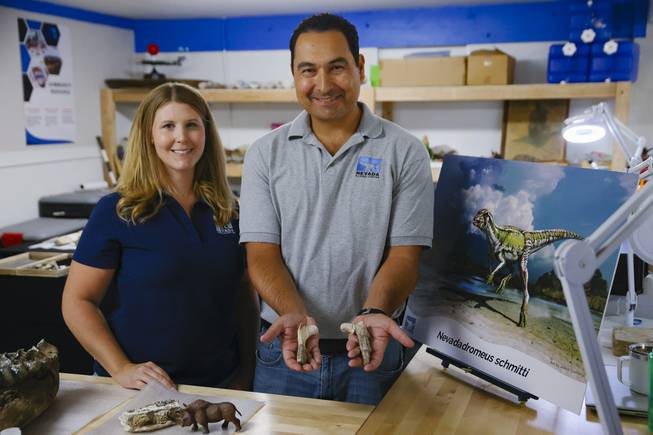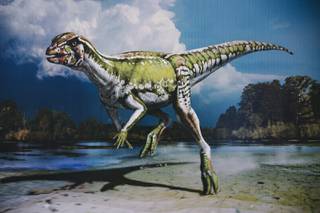
Wife and husband Becky Hall and Joshua Bonde pose for a photo with the fossilized bones of a Nevadadromeus schmitti at their Nevada Science Center, which opens Thursday, Oct. 7, 2021, in Henderson. Bonde first discovered fossils of Nevadadromeus schmitti, a massive scaly green chickenlike dinosaur, during a paleontology visit to Valley of Fire State Park in 2008. He worked 13 years before finally being able to introduce the newly discovered species last month to the scientific world.
Tuesday, Oct. 5, 2021 | 2 a.m.
Tens of millions of years ago, dinosaurs, including a small, zippy plant-eater that resembled a massive scaly green chicken, roamed the area that is now Southern Nevada.
It was Nevadadromeus schmitti, the first dinosaur unique to Nevada, according to Las Vegas paleontologist Joshua Bonde.
Bonde meticulously freed the fossilized bones of Nevadadromeus schmitti from the tan sandstone of Valley of Fire’s backcountry and vetted them more than 13 years before formally introducing the dinosaur to the scientific community last month.
Bonde describes the discovery process as similar to putting together a jigsaw puzzle; if some of the pieces were missing, there was no picture on a box to follow, and the fragments were scattered in varying condition.
In these bones are stories of the Earth hundreds of millions of years past.
Newly discovered species of dinosaur are identified, somewhere in the world, once or twice a month, Bonde said. That’s not surprising because among all lifeforms, more species are extinct than alive.
“They’re just waiting in the rocks for those stories to be told,” he said.
It was a hot, monsoonal day in 2008 when Bonde, then a doctoral student at UNLV, and a group of geology students visiting Valley of Fire State Park from Montana State University hunkered down to ride out a thunderstorm.
Most visitors to the park, about an hour’s drive northeast of Las Vegas, come to appreciate the flaming red sandstone not far from the road. Paleontologists, who study ancient life, go much farther to find the fossils. This crew was another hour’s hike deep, so with no car or picnic shelter handy they just tucked their heads down.
That’s a common posture for a paleontologist, and with better contrast because the earth was wet, “the bones just really popped out,” Bonde said.
The remains weren’t complete — mainly femurs, or thigh bones, and pieces of a foot and vertebra. But the complete heads of both femurs — knobs that go into the hip sockets — make it easy to visualize an upright, breathing, running creature. An intact spiny protrusion that likely attached to a ligament, connecting the leg to the tail, sets it apart as a new species, Bonde said.
He named it for his mentor Jim Schmitt, a geology and paleontology professor at Montana State and UNLV who urged him to explore in Valley of Fire.
Bonde’s find is part of the dromaeosauridae (“running lizard”) family, a broad classification of dinosaurs informally known as raptors because of their birdlike silhouette. He estimates that it was about the size of a large dog, standing hip-high to an adult human and weighing about 100-150 pounds. It relied on its fleet feet to avoid predators, like the descendants of allosaurus and ancestors to tyrannosaurs that lived around the same time.
During the Cretaceous period, when Nevadadromeus roamed, the area that is now Southern Nevada was more like tropical Brazil. Rivers flowed down from the highlands and were lined with magnolias and horsetail reeds. Tree ferns grew where desert scrub is today. Crocodiles lumbered in and out of the water. It was humid and even hotter than it is now. Think of the ambiance as the inside of a lush dishwasher.
The lack of wounds on the bones Bonde found suggests that this particular specimen lived a full life and died on a riverbank, not under another animal’s claws or teeth, before being quickly covered by sediment and preserved.
He admits this isn’t a gloriously fearsome megalizard. This is what those dinosaurs ate.
But this is Nevada can call its very own, an uncommon find in a state that has a rich, complex geologic record but relatively few hotspots to find dinosaur fossils. Dramatic geologic processes known as “mountain-building events” heaved and smashed rock, and many of the biological remains encased in them were lost or weathered. Valley of Fire is one of the places where fossil-hunters can still find stories, explained Bonde and his wife and professional collaborator Becky Hall.
The dromaeosauridae family is widespread, but this newly discovered species is 20 million years older than its North American family members, Bonde said, making it a scientifically significant missing link in dinosaur migration patterns.
Bonde and Hall, former employees of the Las Vegas Natural History Museum, launched the Nevada Science Center last year. Their headquarters on Water Street in Henderson is home to their working laboratory and display cases. The couple will open their space to the public Thursday to show off what they’ve found all around the state.
The fruits of years of discovery and adventure line their shelves and drawers, with bones, teeth, tracks and claws from dinosaurs and other prehistoric creatures. There’s the jaw of a primitive elephant-type animal found near Yerington, with teeth the size of baseballs still in their sockets, and Hall’s collection of hardened mud slabs chipped away from the Lake Mead area showing reptilian footprints and horseshoe crab tracks from the Triassic period — a time even before dinosaurs.
Atop them sits the remains of something bigger, found next to the Nevadadromeus schmitti. This is Hall’s project. She’s using a pneumatic drill to blast away the rock that these bones are cemented in, grain by grain.
Hall isn’t sure what it is yet, so she might find another new species to sit aside Nevadadromeus schmitti.
“For Nevada, the story of dinosaurs hasn’t really been investigated,” she said.

